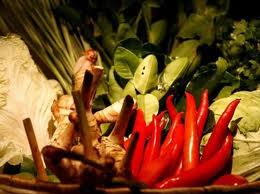
 “The most delicious fruit known to men” is how Mark Twain described the tropical cherimoya, or custard apple, native to the Andean highland valleys of Ecuador, Peru and Chile.
“The most delicious fruit known to men” is how Mark Twain described the tropical cherimoya, or custard apple, native to the Andean highland valleys of Ecuador, Peru and Chile.
Long a favorite of those who’ve had a chance to enjoy its smooth, lusious flesh, this fruit is rarely found for sale commercially here in the United States. It bruises easily, and has a relatively short shelf life. So, you can imagine my delight at finding this delicately flavored but seriously wierd-looking fruit for sale at the Tuesday Culver City Farmers Market. Its flavor is decidedly tropical, and its texture is meltingly sherbert-like. Some describe the cherimoya’s taste as a blend of pineapple, strawberry, banana, and papaya. Others compare it to vanilla custard, especially when the fruit had been deeply chilled and it is being eaten spoonful by spoonful, just like a sherbert or frozen desert.
The exterior of the cherimoya is covered with dusty green, inedible surface. The fruit often looks like a heart, with two distinct halves coming together in a single point at the base of the fruit. The white flesh is easily divided into two portions. Once you open the fruit, you will find large black seeds scattered throughout the flesh. They are easily removed with a spoon, though, and the fruit is ready to be enjoyed.
When choosing a cherimoya, look for a green one which is firm and heavy for its size. Avoid fruits with visible bruising or cracks, as they will not keep long. It’s best to ripen the cherimoya at room temperature. It is ready to eat when the skin responds gently to pressure, like an avocado. The skin and flesh will quickly brown if refrigerated or if it is not eaten within a day or so of its ripening.
Some people will add cherimoya flesh to their smoothie ingredients. Others will add it to a fruit salad, place it on a fruit tart, or use it in a tropical fruit salsa. If you do so, make sure to add a little lime or lemon juice so that the flesh does not turn brown.
From the Farmer’s Table provides two recipes featuring this wonderful fruit.
The Culver City Farmers Market is held each Tuesday from 2 to 7 p.m. on Main Street in between Culver and Venice Boulevards.
Katie Malich agrees with Mark Twain that the cherimoya is “deliciousness itself,” but recognizes that for some people may disagree. (All the more cherimoyas for the rest of us!)
From the Farmer’s Table
The January/February 2010 issue of Sunset magazine printed a recipe for Chile-Lime Shrimp which I’ve adopted to feature cherimoya, cucumber and jicama. The original recipe called for cherimoya and papaya, but I think that the mild taste and firm texture of cucumber and jicama adds an interesting flavor and texture contrast. Important Note- Please remember to remove the seeds!
Chile-Lime Shrimp
(serves 4)
• 1/2 cup fresh lime juice
• 1/2 cup fresh orange juice
• 1 tablespoon packed light brown sugar
• 1 tablespoon mild local honey
• 1/2 teaspoon red chile flakes
• 2 teaspoons vegetable oil
• 1/2 teaspoon salt
• 1 pound (30 to 35 per lb.) peeled, cooked medium shrimp
• 1/4 c. peeled and seeded cucumber, cut into 1/2 – 1/4 inch dice
• 1/2 c. peeled jicama, cut into 1/2- 1/4 inch dice
• 1 ripe cherimoya peeled, seeds left in, and cut into 1-in. chunks
• garnish: leaf lettuce, paprika or Mexican chile powder, and cilantro (optional)
Combine juices, sugar, chile, oil, and salt in a small saucepan and boil over high heat, stirring often, until golden brown and reduced to 2/3 cup, about 5 minutes. In a separate bowl, add shrimp, cucumber, jicama and cherimoya. Toss gently.
Place a leaf or two of washed and dried lettuce on each of the four plates. Divide shrimp mixture into four portions and place on lettuce. Drizzle with dressing. Sprinkle each plate with a pinch of Mexican chile powder or paprika for garnish.
Serve with chopped fresh cilantro leaves on the side for those who enjoy cilantro.





Be the first to comment